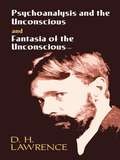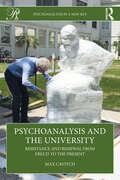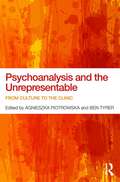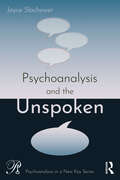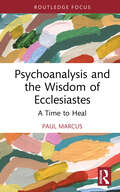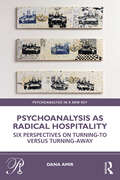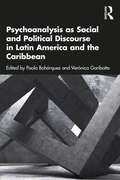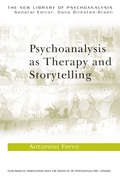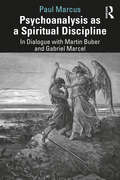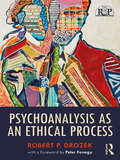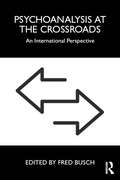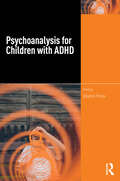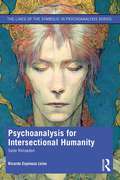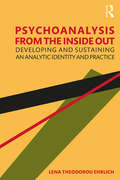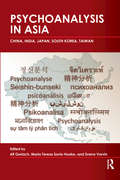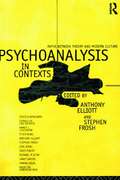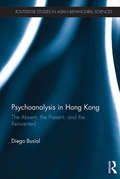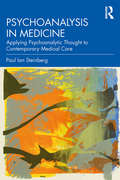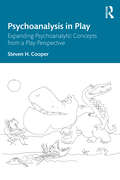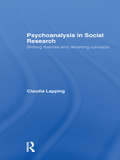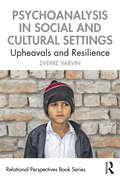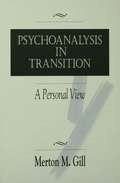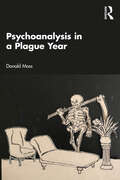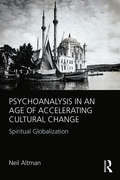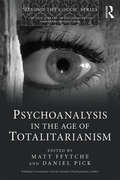- Table View
- List View
Psychoanalysis and the Unconscious and Fantasia of the Unconscious
by D. H. LawrenceThis volume features two profound essays by one of the English language's most famous and controversial authors. D. H. Lawrence wrote Psychoanalysis and the Unconscious and Fantasia of the Unconscious in the early 1920s, during his most productive period. Initially intended as a response to psychoanalytic criticism of his novel Sons and Lovers, these works progressed into a counterproposal to the Freudian psychoanalytic theory of the unconscious and the incest motive. They also voice Lawrence's concepts of education, marriage, and social and political action."This pseudo-philosophy of mine," explained Lawrence, "was deduced from the novels and poems, not the reverse. The absolute need one has for some sort of satisfactory mental attitude towards oneself and things in general makes one try to abstract some definite conclusions from one's experiences as a writer and as a man." With these two essays, the author articulates his insights into the mental struggle to rationalize and reconcile the polarity that exists between emotional and intellectual identities. Critical to understanding Lawrence's other works, they offer a bold synthesis of literary theory and criticism of Freudian psychology.
Psychoanalysis and the University: Resistance and Renewal from Freud to the Present (Psychoanalysis in a New Key Book Series)
by Max CavitchThis book charts the past and present vicissitudes of psychoanalysis’s relation to education and emphasizes on the necessity of its increased presence in university settings.Why can fewer and fewer people afford either time-intensive psychoanalytic psychotherapy or a three- to four-year college education? Why have psychoanalytic teaching and research become so marginalized? Where and how does psychoanalysis retain a foothold in academia? In an era when the futures of both psychoanalysis and higher education seem evermore uncertain, Psychoanalysis and the University argues for the need to overcome existing precarities and mutual resistances and suggests ways in which their prospects for survival could be reciprocally enhanced. Each chapter surveys and interprets present conditions, while arguing the necessity of supporting and expanding psychoanalytic teaching and research at both the undergraduate and graduate levelsDrawing on Cavitch’s deep understanding of both psychoanalysis and university settings, this is essential reading for psychoanalysts, university teachers and administrators, and all students interested in how augmented psychoanalytic education could enhance their understanding of the world.
Psychoanalysis and the Unrepresentable: From culture to the clinic
by Ben Tyrer Agnieszka PiotrowskaPsychoanalysis and the Unrepresentable opens a space for meaningful debate about translating psychoanalytic concepts from the work of clinicians to that of academics and back again. Focusing on the idea of the unrepresentable, this collection of essays by psychoanalysts, psychotherapists, counsellors, artists and film and literary scholars attempts to think through those things that are impossible to be thought through completely. Offering a unique insight into areas like trauma studies, where it is difficult – if not impossible – to express one’s feelings, the collection draws from psychoanalysis in its broadest sense and acts as a gesture against the fixed and the frozen. Psychoanalysis and the Unrepresentable is presented in six parts: Approaching Trauma, Sense and Gesture, Impossible Poetics, Without Words, Wounds and Suture and Auto/Fiction. The chapters therein address topics including touch and speech, adoption, the other and grief, and examine films including Gus Van Sant’s Milk and Michael Haneke’s Amour. As a whole, the book brings to the fore those things which are difficult to speak about, but which must be spoken about. The discussion in this book will be key reading for psychoanalysts, including those in training, psychotherapists and psychotherapeutically-engaged scholars, academics and students of culture studies, psychosocial studies, applied philosophy and film studies, filmmakers and artists.
Psychoanalysis and the Unspoken (Psychoanalysis in a New Key Book Series)
by Joyce SlochowerWhat do therapists not talk about? What do we ignore/miss/sidestep? What factors—personal, social, political—inform our areas of blindness? This book names and explores what psychoanalytic theory often skips over or simplifies—how, when, and why we fail to uphold the professional ideal. Turning a critical eye on her own theory, Slochower reflects on how it, she, and the field have evolved and what remains unspoken. In so doing, she pushes us to do the same. With its sharp focus on both theory and clinical work, this book is essential reading for psychoanalysts and psychotherapists.
Psychoanalysis and the Wisdom of Ecclesiastes: A Time to Heal (Routledge Focus on Mental Health)
by Paul MarcusPsychoanalysis and the Wisdom of Ecclesiastes looks at one of the most profound books in the Hebrew Bible – Ecclesiastes, known as Koheleth in Hebrew – through a psychoanalytic lens.Paul Marcus explores Ecclesiastes’ understanding of the profound and compelling problematics of the human condition and explains how he offers a sensible and feasible attitude toward contemporary life. Comparing Ecclesiastes’ way of looking at life to the Freudian worldview, Marcus suggests what psychoanalysis might in part appropriate or further explore and develop as it tries to enhance itself as a narrative of the human condition and a compelling “technology of the self.” The book also uses psychoanalysis to illuminate aspects of Ecclesiastes that have been underappreciated and undercomprehended.Psychoanalysis and the Wisdom of Ecclesiastes will be of interest to psychoanalysts exploring spirituality and the human condition, and to academics and students of psychoanalytic studies, religious studies, Judaic studies, and philosophy.
Psychoanalysis as Radical Hospitality: Six Perspectives on Turning-to versus Turning-Away (Psychoanalysis in a New Key Book Series)
by Dana AmirThis book focuses on different forms of turning-to versus turning-away from speech across a range of experiences in clinical treatment and general life.The chapters of this volume deal with the entrapment involved in exile from mother tongue, the parasitic language that uses the other's language as a linguistic prosthesis, the language of blank mourning which separates the mourner from their mourning, the adhesive identification of the voice and the psychotic split between voice and meaning, the mental hypotonia associated with an internalized object that turns away, and the spectrum between revenge and forgiveness. Each chapter sheds light on a different angle of the psyche's ability to spot its own leverage point and use it to transcend the infinite varieties of helpless victimhood: from the position of the victim to the position of the witness, from being the object of the narrative to being its subject, and from the position of righteousness to the willingness to forgive and be forgiven.This book is a must read for psychoanalysts, psychotherapists and literary scholars, as well as philosophers of language and of the mind.
Psychoanalysis as Social and Political Discourse in Latin America and the Caribbean
by Verónica Garibotto Paola BohórquezThis book offers a regional, intersectional, and transnational perspective of psychoanalysis in Latin America and the Caribbean that illuminates psychoanalysis's role as social and political discourse through a collection of original interventions in the fields of psychoanalysis, cultural studies, psychology, anthropology, health sciences, history, and philosophy. The authors contribute to discussions about the applicability of psychoanalytic concepts to reading Latin American and Caribbean sociopolitical phenomona as well as how these regionally specific dimensions challenge and transform traditional psychoanalytic notions. Firstly, the book offers a regional overview of psychoanalysis as a discourse that reflects on the imbrication between the psychic and the sociopolitical. Secondly, it showcases intersectional perspectives that illuminate psychoanalysis's potentials and limitations in addressing contemporary problematics around race, gender, sexuality, and class. Finally, the book attests to the area's role in advancing psychoanalysis as a transnational discipline. By providing both a balanced regional overview and an interdisciplinary perspective, the volume will be essential for all psychoanalysts and scholars wanting to undersrand the place of psychoanalysis in Latin American and Caribbean discourse.
Psychoanalysis as Therapy and Storytelling (The New Library of Psychoanalysis)
by Antonino FerroIs psychoanalysis a type of literature? Can telling 'stories' help us to get at the truth? Psychoanalysis as Therapy and Storytelling examines psychoanalysis from two perspectives - as a cure for psychic suffering, and as a series of stories told between patient and analyst. Antonino Ferro uses numerous clinical examples to investigate how narration and interpretation are interconnected in the analytic session. He draws on and develops Bion's theories to present a novel perspective on subjects such as: psychoanalysis as a particular form of literature sexuality as a narrative genre or dialect in the analyst's consulting room delusion and hallucination acting out, the countertransference and the transgenerational field play: characters, narrations and interpretations. Psychoanalytic clinicians and theoreticians alike will find the innovative approach to the analytic session described here of great interest. Winner of the 2007 Sigourney Award.
Psychoanalysis as a Spiritual Discipline: In Dialogue with Martin Buber and Gabriel Marcel
by Paul MarcusThe great existential psychiatrist Ludwig Binswanger famously pointed out to Freud that therapeutic failure could "only be understood as the result of something which could be called a deficiency of spirit." Binswanger was surprised when Freud agreed, asserting, "Yes, spirit is everything." However, spirit and the spiritual realm have largely been dropped from mainstream psychoanalytic theory and practice. This book seeks to help revitalize a culturally aging psychoanalysis that is in conceptual and clinical disarray in the marketplace of ideas and is viewed as a "theory in crisis" no longer regarded as the primary therapy for those who are suffering. The author argues that psychoanalysis and psychoanalytic psychotherapy can be reinvigorated as a discipline if it is animated by the powerfully evocative spiritual, moral, and ethical insights of two dialogical personalist religious philosophers—Martin Buber, a Jew, and Gabriel Marcel, a Catholic—who both initiated a "Copernican revolution" in human thought. In chapters that focus on love, work, faith, suffering, and clinical practice, Paul Marcus shows how the spiritual optic of Buber and Marcel can help revive and refresh psychoanalysis, and bring it back into the light by communicating its inherent vitality, power, and relevance to the mental health community and to those who seek psychoanalytic treatment.
Psychoanalysis as an Ethical Process (Relational Perspectives Book Series)
by Robert P. DrozekWhat role does ethics play in the practice of psychoanalysis and psychotherapy? For most of its history, psychoanalysis has viewed ethics as a "side issue" in clinical work—occasionally relevant, but not central to therapeutic action. In Psychoanalysis as an Ethical Process, Robert Drozek highlights the foundational importance of ethical experience in the therapeutic relationship, as well as the role that ethical commitments have played in inspiring what has been called the "relational turn" in psychoanalysis. Using vivid clinical examples from the treatment of patients with severe personality disorders, Drozek sketches out an ethically grounded vision of analytic process, wherein analyst and patient are engaged in the co-construction of an intersubjective space that is progressively more consistent with their intrinsic worth as human beings. Psychoanalysis can thus be seen as a unique vehicle for therapeutic and ethical change, leading to a dramatic expansion of agency, altruism, and self-esteem for both participants. By bringing our analytic theories into closer contact with our ethical experiences as human beings, we can connect more fully with the fundamental humanity that unites us with our patients, and that serves as the basis for deep and lasting therapeutic change. This book will be of interest to psychotherapists and psychoanalysts, as well as scholars in ethical theory and philosophy.
Psychoanalysis at the Crossroads: An International Perspective
by Fred BuschIn this clear and thoughtful book, an international group of distinguished authors explore the central issues and future directions facing psychoanalytic theory and practice. The book explores four main questions in the development of psychoanalysis: what psychoanalysis is as an endeavour now and what it may be in the future; the effect of social issues on psychoanalysis and of psychoanalysis on social issues, such as race and gender; the importance of psychoanalytic institutes on shaping future psychoanalytic theory and practice; and the likely major issues that will be shaping psychoanalysis in years to come. Including contributions from within every school of psychoanalytic thought, this book is essential reading for psychoanalysts, psychoanalytic psychotherapists and all who are curious about the future directions of the profession.
Psychoanalysis for Children with ADHD
by Sébastien PonnouIn Psychoanalysis for Children with ADHD, a group of eminent analysts highlight the positive impact that psychoanalytic work and the clinical space can have on children with Attention Deficit Hyperactivity Disorder.Thoroughly researched and informed by decades of work in the field, this volume includes contributions from well-known scientists and analysts such as François Gonon and Patrick Landman. Each contribution addresses sensitive and complex issues, including diagnostic criteria, behavioral problems and patterns, pharmacological intervention, ethical implications and the involvement of parents in treatment. Based on empirical data, the contributors offer a well-balanced critique of standardized approaches to ADHD, and make a case for psychoanalysis as an indispensable tool for both the child with ADHD and their caregivers. Throughout, the book shares the importance of the child having a safe space to explain, in their own words, their mind-body experience. Written in accessible language, this volume will be of interest to all psychoanalysts and psychotherapists working with children, as well as those offering specialized care in a medical or educational setting.
Psychoanalysis for Intersectional Humanity: Sade Reloaded
by Ricardo Espinoza LolasPsychoanalysis for Intersectional Humanity considers both the vast realm of sexual diversities emerging under capitalism and outlines what a psychoanalytic clinic that considers these diversities should be like. Ricardo Espinoza Lolas explores these themes hand in hand with the Marquis de Sade, exploring the monstrous side of our existence – not as a negative aspect of humanity, but as a part of us that strives for a freer and more inclusive life. Espinoza Lolas explores aspects of psychoanalysis, feminism, critical theory, philosophy, history, politics and the arts in considering how human determination can be torn from ego and neurosis. The book concludes with a disarticulation of the categories of neurosis, psychosis and perversion of psychoanalysis and the suggestion of a new clinic and a new politics. Psychoanalysis for Intersectional Humanity will be of great interest to psychoanalysts in practice and in training, Lacanian clinicians and scholars of psychoanalytic studies, philosophy and critical theory.
Psychoanalysis from the Inside Out: Developing and Sustaining an Analytic Identity and Practice
by Lena Theodorou EhrlichIn the face of considerable scepticism over the function and effectiveness of psychoanalysis, Lena Ehrlich demonstrates how analysis is unique in its potential to transform patients at an emotionally cellular level by helping them access and process long-standing conflicts and traumatic experiences. Using detailed clinical vignettes, the author illustrates that when analysts practice from the inside out, i.e. consider that external obstacles to initiating and deepening an analysis inevitably reflect analysts’ fears of their internal world and of intimacy, they become better able to speak to patients’ long-term suffering. This book, free from psychoanalytic jargon, stands out in its ability to help readers feel more effective, confident, and optimistic about practicing psychoanalysis by providing insights and recommendations about beginning and deepening analysis and sustaining oneself as an analyst over time. It will appeal to both beginners and experienced analysts, as well as supervisors, educators, and those interested in the workings of their minds and in building more intimate relationships.
Psychoanalysis in Asia: China, India, Japan, South Korea, Taiwan
by Alf Gerlach Maria Teresa Savio Hooke Sverre VarvinThe world is looking East. Whilst in the West psychoanalysis is fighting to maintain its position among the other therapies in a society which has less time for introspection and self-reflective thought, in Asia a new frontier is opening up: we are witnessing a surge of interest for psychoanalysis among the mental health professionals and among the younger generations, interest which is articulated and nuanced differently in the different Asian countries. In Asia and particularly in India, Japan, South Korea, Taiwan and China, the development of psychoanalysis reflects separate socio-political historical contexts, each with a rich cultural texture and fuelled by the interest of a new generation of mental health professionals for psychoanalysis as a therapeutic method.
Psychoanalysis in Context: Paths between Theory and Modern Culture
by Anthony Elliott Stephen FroshDuring the last decade and a half there have been dramatic changes in psychoanalytic theory, as well as in cultural, social and political theory. Psychoanalysis in Contexts examines these changes and explores the relationship between psychoanalysis and theory. The volume brings together leading scholars and practitioners in psychoanalysis to develop a unique rethinking of the relations between subjectivity and inter-subjectivity, sexual difference and gender power, and unconscious desire and political change. Psychoanalysis in Contexts creates a dialogue between different psychoanalytic approaches to the study of subjectivity, social action and modern societies. It will be essential reading for everyone interested in the future direction of psychoanalytic and cultural theory.
Psychoanalysis in Hong Kong: The Absent, the Present, and the Reinvented (Routledge Studies in Asian Behavioural Sciences)
by Diego BusiolHow is it possible that a phenomenon like psychoanalysis, which has dominated the cultural and intellectual life of the last century in Europe, North and South America, has seemingly had little-to-no resonance in Hong Kong? This book attempts to explain this phenomenon. Addressing the subject from an East to West approach, this book proposes an experience of displacement, as it is argued that the opportunity for psychoanalysis today is not just to be exported to the East, but rather to be re-invented after an encounter with a radically different culture. This encounter allows the Western practitioner to question their experience and highlights the assumptions of Western thought and knowledge. Following this, what remains of psychoanalysis as we know it? How can psychoanalysis be re-thought and re-formed today in a format independent of different theoretical orientations and schools? The book addresses key issues such as: Is there psychoanalysis in Hong Kong? How does one do research on psychoanalysis in Hong Kong? Why was the Freudian Unconscious not discovered in China? How can we describe the core of psychoanalysis and how can this description be understood in different cultural contexts? Can psychoanalytic research be led by adopting a quantitative or statistical methodology? Founded on the belief that psychoanalysis should be re-invented in light of its encounter with non-Western cultures, this book highlights an opportunity to undertake this as an intellectual, cultural and artistic challenge. It will enrich researchers’ and students’ understanding of psychoanalysis and inform broader views of psychoanalysis in non-Western contexts. Practicing psychoanalysts, students of psychoanalysis and those seeking to understand psychanalysis in different cultural contexts will be particularly interested readers.
Psychoanalysis in Medicine: Applying Psychoanalytic Thought to Contemporary Medical Care
by Paul Ian SteinbergThis book shows how contemporary psychoanalytic thinking can be applied in the everyday practice of medicine to enhance the practice of family medicine and all clinical specialties. Dr. Steinberg analyzes his writings over the past 35 years—on psychiatry and family medicine, liaison psychiatry, and supervision and mentoring—based on developments in psychoanalytic thinking. Divided into sections based on different venues of medical practice, including family medicine clinics, inpatient medical and surgical units, and psychiatric inpatient units and outpatient programs, chapters illustrate how various concepts in psychoanalysis can enhance physicians’ understanding and management of their patients. A concluding section contains applications of psychoanalytic thought in non-clinical areas pertinent to medicine, including preventing suicide among physicians, residents, and medical students, sexual abuse of patients by physicians, and oral examination anxiety in physicians. Readers will learn to apply psychoanalytic concepts with a rational approach that enhances their understanding and management of their patients and practice of medicine generally.
Psychoanalysis in Play: Expanding Psychoanalytic Concepts from a Play Perspective
by Steven H. CooperIn this book, Steven H. Cooper expands on his thinking of psychoanalysis as a form of play and the implications of this for theory and clinical practice.The most important activities of the analyst as a usable object for the patient have to do with finding the patient’s creative elements of self. Cooper illuminates this process of finding within both patient and analyst. He illuminates how play processes occur in relation to such concepts as defense, temporality, and neutrality within the analytic situation. Along the way, he theorizes a complex but usable clinical relationship between becoming and knowing in psychoanalytic work.With rich clinical vignettes and a fresh take on the nature and practice of psychoanalysis, this book is key reading for all psychoanalysts and psychoanalytic psychotherapists.
Psychoanalysis in Social Research: Shifting theories and reframing concepts
by Claudia LappingThe use of psychoanalytic ideas to explore social and political questions is not new. Freud began this work himself and social research has consistently drawn on his ideas. This makes perfect sense. Social and political theory must find ways to conceptualise the relation between human subjects and our social environment; and the distinctive and intense observation of individual psychical structuring afforded within clinical psychoanalysis has given rise to rich theoretical and methodological resources for doing just this. However, psychoanalytic concepts do not remain the same when they are rearticulated in the context of research. This book traces the reiteration and transformation of concepts in the psychoanalytic theory of Freud, Klein and Lacan, the social theory of Butler, Derrida, Foucault, Laclau and Zizek, and case studies of empirical research ranging from the classic Tavistock Institute studies to contemporary work in politics, gender studies, cultural studies and education. Each chapter explores one cluster of concepts: Melancholia, loss and subjectivity Overdetermination and free association Resistance, reflexivity and the compulsion to repeat Repression, disavowal and foreclosure Psychic defenses and social defenses Arguing against the reification of psychoanalytic concepts, Claudia Lapping suggests the need for a reflexive understanding of the play of attachments and substitutions as concepts are reframed in the contrasting activities of psychoanalysis and research.
Psychoanalysis in Social and Cultural Settings: Upheavals and Resilience (Relational Perspectives Book Series)
by Sverre VarvinPsychoanalysis in Social and Cultural Settings examines the theory and practice of psychoanalysis with patients who have experienced deeply traumatic experiences through war, forced migrations, atrocities and other social and cultural dislocations. The book is divided into three main sections covering terrorism, refugees and traumatisation, with another two focusing specifically on transcultural issues regarding establishing psychoanalysis in China and on research related to themes outlined in the book. Major key psychoanalytic themes run through the work, focusing on identity and the self, fundamentalism, resilience, dehumanisation, cultural differences and enactment. Offering key theory and clinical guidance for working with highly traumatised patients, this book will be essential for all psychoanalysts and therapists working with victims of terrorism, war and other deeply traumatic life events.
Psychoanalysis in Transition: A Personal View
by Merton M. GillFirst published in 2000. Routledge is an imprint of Taylor & Francis, an informa company.
Psychoanalysis in a Plague Year
by Donald MossSelecting one sentence from each session every day, Donald Moss has recorded the words spoken by his patients during one year of ‘Covid-time’. The patients conjure a moving mixture of the mundane and extraordinary, giving readers a perspective on psychoanalytic practice and treatment during the COVID-19 pandemic. Clustered together in ways akin to poetic verse, these sentences preserve the mood of the analyst’s working day, reflecting the common ground shared by analyst and patient in these unprecedented times. Pandemic-related concerns and everyday problems are seen to persist in these extreme circumstances, affording the reader clinical insights into the daily life of contemporary psychoanalysts. With a clear preface from the author and a remarkable foreword by Timothy J. Clark, the book is grounded in a contemporary psychoanalytic context. An insightful companion into psychoanalytic practice, the book will interest therapists and analysts in training and in practice, as well as readers intrigued by what happens behind the closed doors of the consulting room.
Psychoanalysis in an Age of Accelerating Cultural Change: Spiritual Globalization
by Neil AltmanPsychoanalysis in an Age of Accelerating Cultural Change: Spiritual Globalization addresses the current status of mental health work in the public and private sectors. The careful, thorough, approach to the individual person characteristic of psychoanalysis is mostly the province of an affluent few. Meanwhile, community-based mental health treatment, given shrinking budgets, tends to emphasize medication and short-term therapies. In an increasingly diverse society, considerations of culture in mental health treatment are given short shrift, despite obligatory nods to cultural competence. The field of mental health has suffered from the mutual isolation of psychoanalysis, community-based clinical work, and cultural studies. Here, Neil Altman shows how these areas of study and practice require and enrich each other - the field of psychoanalysis benefits by engaging marginalized communities; community-based clinical work benefits from psychoanalytic concepts, while all forms of clinical work benefit from awareness of culture. Including reports of clinical experiences and programmatic developments from around the world, its international scope explores the operation of culture and cultural differences in conceptions of mental health. In addition the book addresses the origin and treatment of mental illness, from notions of spirit possession treated by shamans, to conceptions of psychic trauma, to biological understandings and pharmacological treatments. In the background of this discussion is globalization, the impact of which is tracked in terms of its psychological effects on people, as well as on the resources and programs available to provide psychological care around the world. As a unique examination of current mental health work, this book will appeal to psychoanalysts, psychotherapists, community-based mental health workers, and students in Cultural Studies. Neil Altman is a psychoanalytic psychologist, Visiting Professor at Ambedkar University of Delhi, India, and faculty and supervisor at the William Alanson White Institute. He is an Honorary Member of the William Alanson White Society and Editor Emeritus of Psychoanalytic Dialogues. Author of The Analyst in the Inner City: Race, Class, and Culture through a Psychoanalytic Lens (Routledge, 2nd edition, 2010)
Psychoanalysis in the Age of Totalitarianism (The New Library of Psychoanalysis 'Beyond the Couch' Series)
by Matt Ffytche Daniel PickPsychoanalysis in the Age of Totalitarianism provides rich new insights into the history of political thought and clinical knowledge. In these chapters, internationally renowned historians and cultural theorists discuss landmark debates about the uses and abuses of ‘the talking cure’ and map the diverse psychologies and therapeutic practices that have featured in and against tyrannical, modern regimes. These essays show both how the Freudian movement responded to and was transformed by the rise of fascism and communism, the Second World War, and the Cold War, and how powerful new ideas about aggression, destructiveness, control, obedience and psychological freedom were taken up in the investigation of politics. They identify important intersections between clinical debate, political analysis, and theories of minds and groups, and trace influential ideas about totalitarianism that took root in modern culture after 1918, and still resonate in the twenty-first century. At the same time, they suggest how the emergent discourses of ‘totalitarian’ society were permeated by visions of the unconscious. Topics include: the psychoanalytic theorizations of anti-Semitism; the psychological origins and impact of Nazism; the post-war struggle to rebuild liberal democracy; state-funded experiments in mind control in Cold War America; coercive ‘re-education’ programmes in Eastern Europe, and the role of psychoanalysis in the politics of decolonization. A concluding trio of chapters argues, in various ways, for the continuing relevance of psychoanalysis, and of these mid-century debates over the psychology of power, submission and freedom in modern mass society. Psychoanalysis in the Age of Totalitarianism will prove compelling for both specialists and readers with a general interest in modern psychology, politics, culture and society, and in psychoanalysis. The material is relevant for academics and post-graduate students in the human, social and political sciences, the clinical professions, the historical profession and the humanities more widely.
